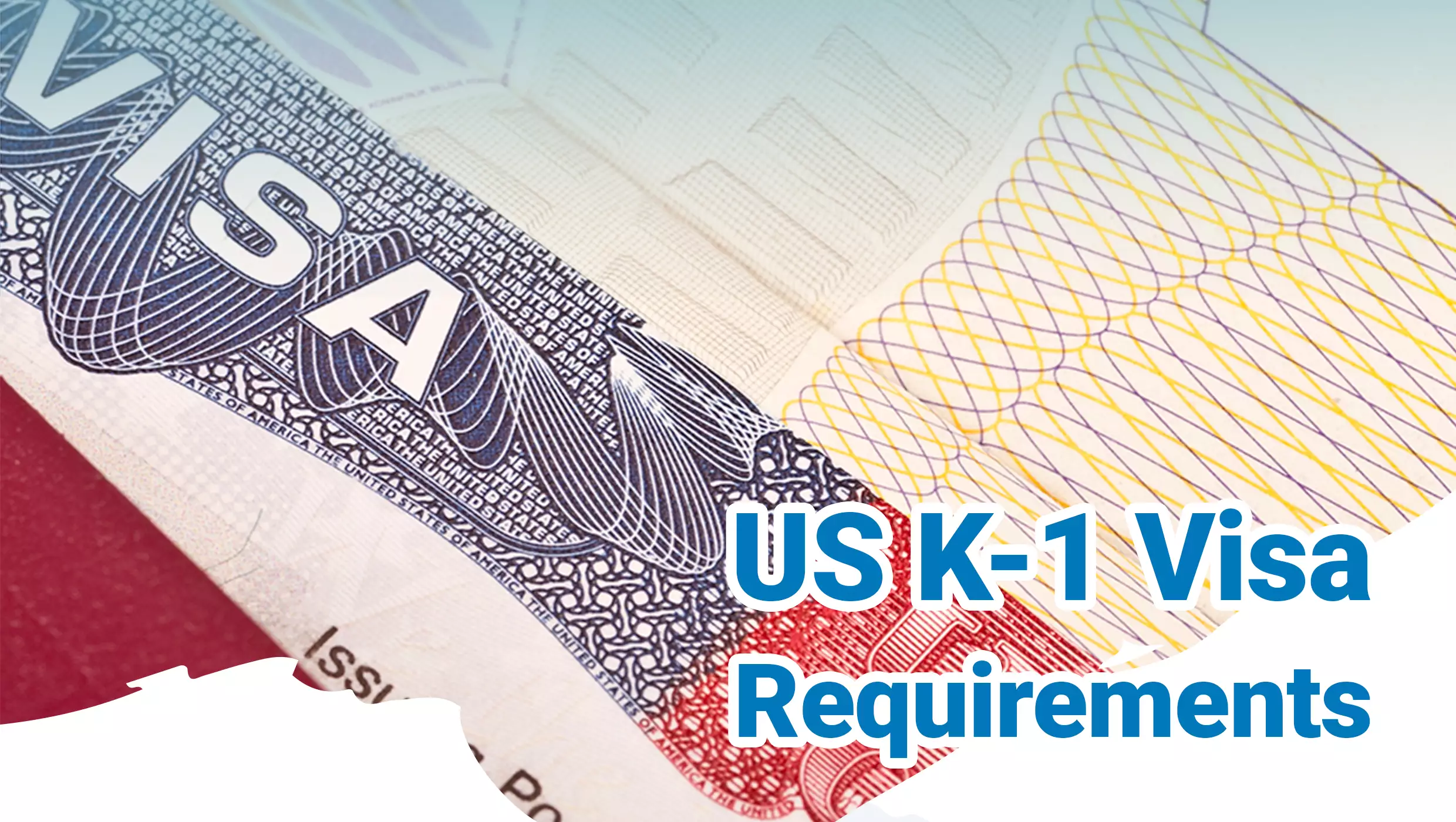US K1 Visa Requirements in Thailand
If you've met your fiancé(e) abroad, the prospect of bringing them to the US to start your life together can be both exciting and overwhelming. Luckily, the K-1 fiancé(e) visa allows your foreign fiancé(e) to enter the US to marry you and then later apply for a green card and receive immigration benefits.
However, securing this visa requires you, your fiancé(e), and your relationship to meet specific criteria. This article breaks down the essential requirements for the K-1 visa so you and your fiancé(e) can make the United States your home.

K1 Visa Requirements Overview
To be eligible for the K-1 visa, you and your foreign citizen fiancé(e) must meet the K-1 visa requirements under US immigration law.
Requirements for the American Partner
As the US-based partner, you must meet the following criteria:
- You must be a US citizen. You must be able to demonstrate your citizenship to United States Citizenship and Immigration Services (USCIS) with one of the following documents:
- US birth certificate
- US passport
- Statement from a consular officer verifying citizenship
- Form FS-240 issued by the US Department of State
- Certificate of Naturalization or Certificate of Citizenship
- Passport card issued by the Department of State
- You must be able to financially support your partner and any accompanying dependent children.
- You must be free to marry.
- You should generally have a clean criminal record.
Unfortunately, if you are a US lawful permanent resident, you cannot petition for a K-1 visa for your fiancé(e). However, you may qualify to submit a marriage-based green card application to bring your foreign spouse to the US if you marry abroad.
Requirements for the Thai Partner
Your fiancé(e) must meet the following requirements to be eligible for a K-1 visa:
- They must live outside the United States.
- Your fiancé(e) must be free to marry.
- They should not be inadmissible under US law.
- They typically must have a clean criminal record.
Relationship Requirements
Lastly, not all relationships qualify for the K-1 visa. Check the following requirements to see if your relationship qualifies:
- You and your fiancé(e) must have met in person in the last two years. There are some limited exceptions for extreme hardship or cultural reasons, but generally, proof of an in-person meeting is required.
- You and your fiancé(e) must have a real, genuine relationship.
- You and your fiancé(e) must intend to marry within 90 days of their arrival in the US.
The following sections will explore each element of the K-1 visa eligibility criteria in-depth.
Financial Requirements for K-1 Sponsorship
To sponsor your fiancé(e) for a K-1 visa, you must prove your ability to financially support them after they enter the United States. The minimum income requirements are set at 100% of the Federal Poverty Guidelines (FPG) for your household size.
In 2024, for a household of two (you and your fiancé(e)), this requires an annual income of at least 20,440 USD. It's important to note that the FPG is adjusted annually, so be sure to consult the latest guidelines published by the US Department of Health and Human Services for the most up-to-date information.
If your individual income falls below the requirement, you can include a joint sponsor in your application. This joint sponsor, a US citizen or lawful permanent resident, must have sufficient income to support your entire household. You must fill out a Form I-134, Declaration of Financial Support certifying that your income meets or exceeds the FPG.
There are no income requirements for your foreign citizen fiancé(e).
2024 HHS Poverty Guidelines for Immigrant Visa Processing
| Persons in Family or Household | 48 Contiguous States and D.C. | Alaska | Hawaii |
| 1 | $15,060 | $18,810 | $17,310 |
| 2 | $20,440 | $25,540 | $23,500 |
| 3 | $25,820 | $32,270 | $29,690 |
| 4 | $31,200 | $39,000 | $35,880 |
| 5 | $36,580 | $45,730 | $42,070 |
| 6 | $41,960 | $52,460 | $48,260 |
| 7 | $47,340 | $51,190 | $54,450 |
| 8 | $52,720 | $65,920 | $60,640 |
| For each additional person, add | $5,380 | $6,730 | $6,190 |
Free to Marry Requirement
You and your fiancé(e) must demonstrate that you are both legally free to marry. This means you must both be at least 18 years of age and, if you or your fiancé(e) was ever previously married, you will need to provide evidence that any marriage was terminated either through divorce, annulment, or death of a spouse. This requires the following original copies of the following evidence:
- Divorce decree;
- Annulment order; or
- Death certificate.
Legal separation is not accepted.
Requirements to Have Met in the Last Two Years
You need to show that you, the US citizen sponsor, and your Thai citizen partner have met in person within the last two years before applying for the K-1 visa. There are limited exceptions to the in-person meeting requirement. USCIS may waive the requirement if:
- Meeting in person would cause extreme hardship.
- Meeting before marriage violates a long-established religious or cultural tradition for either you or your partner. For example, some cultures don't allow couples to meet in person before marriage.
If you fall into either category, you'll need to provide documentation to prove it. Examples of acceptable documentation include:
- Letters from religious leaders (such as a priest, rabbi, or imam) confirming your adherence to a religious practice that prevents meeting in person.
- Statements from friends and family attesting to your fiancé(e)'s or your observance of a cultural or religious practice that hinders an in-person meeting.
- News articles documenting political unrest that makes travel unsafe.
- Medical records or doctor's reports verifying health reasons that prevent you from meeting in person.
Bona Fide Relationship Requirement
USCIS requires evidence that you and your fiancé(e) have a genuine, love-based relationship and that your fiancé(e) has an honest intention to enter the United States to marry you. Evidence of a bona fide relationship might include:
- Photographs: High-quality, dated color photos together
- Correspondences: Emails and text messages, phone records, social media exchanges, or letters
- Travel Documents: Copies of air travel bookings, train tickets, or travel itineraries can help demonstrate in-person visits
- Engagement Ring Receipt (Optional): A receipt for an engagement ring can show an honest intent to marry
Grounds of Inadmissibility
Several factors can lead to being considered inadmissible under US homeland security law:
- Criminal History: Depending on the nature and severity of the offense(s), authorities could deem your fiancé(e) inadmissible if they have a criminal record.
- Health Concerns: If your partner tests positive for certain certain communicable diseases or lacks required vaccinations, their application could be denied.
- Past Behavior: Physical or mental disabilities related to past aggressive or threatening behavior may be grounds for inadmissibility.
If you believe your fiancé(e) could be deemed inadmissible by US authorities, they should apply for a waiver by filing a Form I-601, Application for Waiver of Grounds of Inadmissibility. With the waiver, you can then petition for the K-1 visa on their behalf.
Intention to Marry within 90 Days
Immigration authorities must believe that you and your fiancé(e) plan to marry within 90 days of their entry into the United States. During your partner's visa interview, they will need to provide evidence to assure the consular officer that you have real plans and that you are aware of the limited timeframe.

Applying for a K-1 Visa
If your relationship meets the K-1 visa requirements, you're ready to start the application process.
Filing a Form-129F, Petition for Alien Fiancé
The K-1 visa journey begins with Form I-129F, Petition for Alien Fiancé(e). As the US citizen petitioner, you file this form with USCIS on behalf of your foreign fiancé(e) along with a 675 USD filing fee.
In addition to the form, you'll need to gather supporting documentation that proves your eligibility. Here's a breakdown of the key requirements:
- Proof of your US Citizenship: This could be a birth certificate, valid U.S. passport, or naturalization certificate.
- Evidence of Previous Marriage Termination (if applicable): If either of you has been married before, you'll need documentation proving those marriages have legally ended.
- Passport-Style Photos: One recent photo of each partner (you, the US citizen, and your fiancé(e)) meeting passport photo specifications.
- Proof of Legal Name Change (if applicable): Documentation is needed if either of you has legally changed your name.
- Evidence of Bona Fide Relationship: This is the most crucial part. You need to demonstrate a legitimate relationship, having met in person in the last two years, and a genuine intent to marry.
- Certified Translations: If any documents are not in English, you'll need certified translations.
- Dependent Children: If your partner is applying concurrently for K-2 visas for dependent children, they should be listed on the Form I-129F.
If you or your partner has a criminal background, you may need:
- Certified copies of all court and police documents showing charges and dispositions for any convictions.
- Evidence to secure a waiver for the International Marriage Broker Act (IMBRA).
National Visa Center and Pre-Interview Steps
Upon approval of the petition, USCIS will issue an Approval Notice and transfer your case to the National Visa Center (NVC) for further processing. The NVC then assigns the petition a case number and forwards it to the US Embassy in Bangkok.
Now, your fiancé(e) must prepare for the in-person visa interview. The Embassy will inform your partner of the required interview documents and provide instructions to schedule a medical exam with an authorized physician. Eligible children who have been listed on the I-129F must also attend the visa interview and undergo a medical exam.
At the medical exam, the physician ensures that your fiancé(e) and their child(ren) are not inadmissible to the US under medical grounds and that they have all required vaccinations for a nonimmigrant visa. However, K visa applicants are also encouraged to receive all the vaccinations required for US immigrant visas because they will be required when they apply for a green card.
K Visa Interview
Your fiancé(e) and their child(ren) must bring the following original documentation to the interview:
- Confirmation page of the Form DS-160, Online Nonimmigrant Visa Application (for each applicant)
- Valid passport (for each visa applicant)
- Birth certificate (for each applicant)
- Any relevant divorce or death certificates
- Police certificates from current country of residence and all countries of residence since the age of 16 (for all applicants over 15 years old)
- Medical examinations (for each applicant)
- Evidence of financial support (covering all applicants)
- Two passport-style photographs (for each applicant)
- Evidence of your genuine relationship
- Certified translations of documents in languages other than English and Thai languages
- Any other evidence requested at the discretion of the consular officer
During the interview, the consular officer examines the evidence submitted. Your fiancé(e) will be placed under oath and questioned about their application, including their background and your relationship. If the officer is convinced your relationship is genuine and there are no legal impediments, they will approve the K-1 visa, along with any accompanying K-2 visas.
Post-Approval K1 Visa Requirements
Once the visa is approved, your fiancé(e) will be given a visa stamp and a packet of documents. Your fiancé(e) must arrive at a US port of entry within 6 months of the approval date of the I-129F and present this packet of documents to US Customs and Border Protection (CBP) officer. Once admitted into the US, you and your fiancé(e) must get married within the prescribed 90-day period.
If a marriage does not occur within that time, your fiancé(e)'s visa and any dependent K-2 visas expire automatically and they must leave the country.
However, if you do get married within 90 days, you and your foreign spouse must file an immigrant visa Adjustment of Status application, or Form I-485, for your partner to gain permanent residency. This must be filed prior to the expiry of the 90-day K-1 visa. Once the Adjustment of Status application is filed, your fiancé(e) can remain in the US beyond the 90-day limit while USCIS processes the application. Children holding K-2 visas must file separate Adjustment of Status applications.
If your foreign partner wishes to work after entering the US on a K-1 Visa, they can apply for work authorization by filing a Form I-765, Application for Employment Authorization.
K-1 Visa Costs
Account for the following costs and fees when applying for a K-1 visa:
- Form I-129F filing fee - 675 USD
- DS-160 filing fee - 265 USD
- Medical examination - fees can range from 100 USD to over 500 USD
- Miscellaneous costs including translation, photocopying, notarization, and fees for getting the documents required for the visa application (such as passport, police certificates, and birth certificates), and any K-2 applications for dependent children
If you plan to live with your fiancé(e) in the US after your marriage, you will also need to account for Adjustment of Status application costs including:
- Form I-485 filing fee - 1440 USD (or 950 USD for applicants under age 14)
- Work permit or employment authorization document (EAD) - 520 USD
- Advance Parole travel document - 630 USD

How a Thai Lawyer Can Help with Your K-1 Nonimmigrant Visa Application
Planning a life together in the US with your fiancé(e) means navigating the complex K-1 visa process. Luckily, a qualified lawyer gives your visa application the best chance of success. Your lawyer provides the following assistance:
- They review your fiancé(e)'s and your history (including travel and employment) and financial documents to ensure you both meet the K-1 visa requirements.
- If you or your fiancé(e) is ineligible for the K-1 visa, they will recommend a suitable alternative visa or advice to strengthen your application.
- They provide a detailed list of documents required for your application to ensure US authorities have all the evidence needed to prove your eligibility.
- Your lawyer prepares all forms and documents to the preferences of US authorities.
- They manage communications with the US Embassy, USCIS, and other US authorities during the application process.
- Your lawyer coaches your fiancé(e) through the interview process so they come across as honest, confident, and prepared.
- They will answer any visa questions you have throughout the process.

K-1 Visa Requirements Frequently Asked Questions
How do I qualify to bring my fiancé(e) to the US?
In order to sponsor your fiancé(e) for a K-1 nonimmigrant visa, you must meet the following criteria:
- You must be a United States citizen.
- You and your fiancé(e) must have a sincere and good faith intent to marry within 90 days of their arrival in the U.S. on a K-1 visa.
- Both you and your fiancé(e) must be legally eligible to marry.
- You and your fiancé(e) must have met in person within the last two years prior to submitting the I-129F petition, unless you meet the exemption criteria.
I'm a US green card holder (lawful permanent resident). Can I bring my Thai fiancé(e) to the US on a K-1 visa?
No, you must be a US citizen to bring your fiancé(e) to the US on a K-1 visa. However, you can marry your fiancé(e) outside of the United States and then apply for CR-1 visa. This is an application for a marriage-based green card for your spouse.
Who is considered a "fiancé(e)" under US law?
Under US law, a fiancé(e) is an individual you intend to marry, who is at least 18 years of age, and "legally free to marry" at the time the petition is filed and thereafter. "Free to marry" means that an individual is currently unmarried, whether they have never been married or if they are divorced, annulled, or widowed.
What documentation does my fiancé(e) need for the K-1 visa interview?
Your fiancé(e) must bring the following documents to their visa interview:
- Confirmation page of the Form DS-160
- Passport and passport-style photos
- Birth certificate
- Police certificate(s)
- Medical examination
- Evidence of financial support
- Evidence to support your genuine relationship and that you are both free to marry
What documents can serve as evidence of relationship?
USCIS wants to see strong evidence of a genuine relationship including photographs of you and your fiancé(e) together, records of correspondences, and history of living together or travel together. Additionally, an engagement ring receipt can help strengthen your case.
What happens if my fiancé(e) enters the US on a K-1 visa and we miss the 90-day marriage deadline?
There is no option to extend. Your fiancé(e) must leave the US before their visa expires or risk overstaying and deportation. If you think you might not get married in time or that your fiancé(e) has overstayed, consult with a qualified US immigration attorney to discuss possible next steps.
Can the K-1 visa be denied?
Yes, the K-1 visa can be denied if you, your fiancé(e), or your relationship does not meet the requirements for the visa, particularly if officers believe your relationship is not genuine. K-1 visas are issued at the discretion of the consular officer at the US Embassy in Bangkok.
Can my fiancé(e)'s children get K-1 visas?
Your fiancé(e)'s unmarried children under the age of 21 might be eligible for dependent K-2 visas.
Do I need an Affidavit of Support for the K-1 visa?
You, the US citizen, need to provide a Form I-134, Declaration of Financial Support to apply for the K-1 visa. If your fiancé(e) files an Adjustment of Status application for permanent residency, you will need to provide a Form I-864, Affidavit of Support Under Section 213A of the INA.
What's the difference between the Form I-134 and the Form I-864?
The Form I-864 requires you to meet the minimum income standard of 125% of the Federal Poverty Guidelines. You will also likely need to submit your most recent tax return and other financial documents to prove you meet this requirement.
The Form I-134 requires your income to meet at least 100% of the Federal Poverty Guidelines. You do not need to provide supporting evidence with this form.
My fiancé(e) and I are in a same-sex relationship. Are we eligible for the K-1 non-immigrant visa?
Yes. As long as your relationship meets all of the necessary criteria for a K-1 visa, your Thai fiancé(e) is eligible for a K-1 visa.
What is the Form DS-160, Online Nonimmigrant Visa Application?
The DS-160 is a form that must be submitted before the visa interview at the Embassy. It costs 265 USD for K-1 visa applicants.
What is United States Citizenship and Immigration Services?
United States Citizenship and Immigration Services, often abbreviated to USCIS, is an agency within the US Department of Homeland Security. They process the initial Form I-129F, Petition for an Alien Fiancé(e) and prepare it for the National Visa Center (NVC).
Ready to start a new chapter of your life in the USA?
- Over 20 years of experience helping people from all over the world travel to the United States
- More than 10,000 successful US visa applications.

Speak with an expert US immigration lawyer, or submit the form below to begin the consultation process.

Ken Graham
US Immigration Attorney
Partner, Siam Legal International

Natdaphon Luengsawang
Senior US Visa Consultant
Siam Legal International
 CALL
CALL
- Call us today at (702) 799-9719
- From US: Sunday - Friday
- 5:00 PM - 7:00 AM (New York time)
- 2:00 PM - 4:00 AM (Los Angeles time)
- From Thailand: Monday - Friday
- 4:00 AM - 6:00 PM (Bangkok time)













